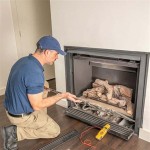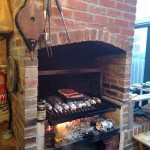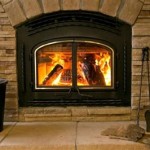Wood Fireplace Parts: A Comprehensive Guide
A wood-burning fireplace can add warmth, ambiance, and charm to any home. While the fireplace itself is the focal point, it is the individual parts that work together to create a safe and efficient fire-burning experience. Understanding the different components of a wood fireplace is essential for both homeowners and those interested in the art of fireplace installation and maintenance.
This article delves into the various parts of a wood fireplace, explaining their functions and significance. From the firebox to the damper, we will explore the essential components that contribute to the overall performance and safety of your fireplace.
Firebox: The Heart of the Fireplace
The firebox is the central chamber of the fireplace where the fire is contained. It is typically constructed from firebrick, cast iron, or steel, materials designed to withstand high temperatures and resist cracking. The size and shape of the firebox influence the volume of wood that can be burned and the efficiency of the fireplace.
A well-designed firebox allows for sufficient airflow, promoting a healthy fire with minimal smoke and creosote buildup. The firebox's design also incorporates features like a grate, which supports the burning wood and allows for ash to fall through. The firebox's placement within the fireplace, often with a raised hearth, facilitates heat distribution and prevents the fireplace from overheating.
Damper: Controlling the Fire
The damper is a crucial part of the fireplace, acting as a gate that controls the flow of air into the firebox. When the damper is open, it allows fresh air to fuel the fire, promoting vigorous burning. When the damper is closed, it restricts airflow, effectively smothering the fire. This ability to regulate airflow is essential for controlling the intensity of the fire, managing smoke, and preventing excess heat loss.
Dampers are typically located at the top of the firebox and can be operated manually with a lever or chain. Modern fireplaces may include automatic dampers that can be controlled remotely or even programmable. The efficiency of a fireplace is greatly influenced by the proper functioning of the damper, ensuring optimal airflow and reducing wasted heat.
Smoke Chamber: The Passageway for Smoke
The smoke chamber is located above the firebox and serves as a passageway for smoke and gases generated by the burning wood. It is typically lined with firebrick or other heat-resistant materials to withstand high temperatures and prevent the accumulation of creosote. The smoke chamber plays a crucial role in directing the upward flow of smoke through the chimney.
The design of the smoke chamber can significantly impact the efficiency and safety of the fireplace. A well-designed smoke chamber promotes smooth smoke flow, minimizing the risk of backdrafting and ensuring safe and complete combustion. Additionally, it helps to prevent the accumulation of smoke, sooty deposits, and creosote, reducing the risk of chimney fires.
Chimney: The Escape Route for Smoke
The chimney is the vertical passageway that extends from the smoke chamber through the roof, allowing smoke and gases to escape into the atmosphere. Constructed from materials such as brick, concrete, stainless steel, or clay tiles, the chimney must be strong enough to withstand the weight and temperature fluctuations associated with the fire.
The chimney's internal lining, typically made of flue tiles or stainless steel, protects the exterior structure from heat damage and facilitates smooth smoke flow. The height of the chimney influences its drafting ability, with taller chimneys generally promoting stronger drafts and easier smoke expulsion. Regular cleaning and maintenance of the chimney are crucial for preventing creosote buildup and reducing the risk of chimney fires.
Other Essential Parts
Beyond the core components, several other parts contribute to the functionality and aesthetics of a wood fireplace. These include:
- Hearth: Often made of stone or brick, the hearth provides a fire-resistant surface below the firebox, protecting the surrounding floor from heat and sparks.
- Mantel: A decorative element above the fireplace, the mantel can be made of wood, stone, or metal and offers a space for displaying artwork or other decorative items.
- Grates: Typically made of cast iron, these grates support the burning wood, allowing air to flow through and promoting efficient combustion.
- Ash Pan: Located below the grate, the ash pan provides a place to collect ash that falls through the grate, making it easier to remove and dispose of.
- Fireplace Screen: Designed to protect the surrounding area from sparks and embers, the screen also adds a decorative element to the fireplace.
Understanding the different parts of a wood fireplace is essential for its safe and efficient operation. By understanding the function of each component, homeowners can make informed decisions regarding maintenance, cleaning, and upgrades. Regular inspection and proper maintenance of all parts are crucial for ensuring a long-lasting and enjoyable fireplace experience.
.png?strip=all)
Superior Merit Series Wood Burning Fireplace Wct2036ws F0685 The Cozy Cabin Lennox Hearth Parts

Signature Series Bwood Lv Wood Burning Fireplace Bwoodlv The Cozy Cabin Lennox Hearth Parts

Osburn Horizon Fireplace Purchase Your From Osburnwoodstoves Com

Informational Blog Fireplace Hearth Chimney Design

Regency F2500 Wood Stove Main Assembly Parts Impressive

Majestic Villawood 42 Outdoor Woodburning Fireplace With Traditional Refractory Odvilla 42t The Cozy Cabin Stove Parts

Osburn Everest Wood Fireplace Parts Ob04015

Ewf30 Wfe05h0 The Cozy Cabin Stove Fireplace Parts

Colonial Series Wood Herringbone Fireplace Col 3629h The Cozy Cabin Lennox Hearth Parts

Regency Replacement Parts Friendly Fires








